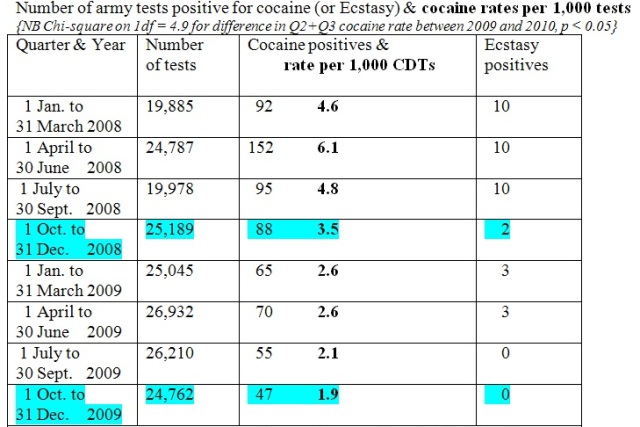Mephedrone and cocaine: clues from Army testing
A Freedom of Information request by The Independent’s Michael Savage in 2009 on the results of compulsory drugs testing (CDT) in the British Army revealed clear evidence that soldiers’ cocaine positive rate per 1,000 tests and ecstasy positive rate had both plummeted between 2008 and 2009.
Patrick Mercer therefore asked for the CDT results to be made available by quarter-year in 2008 and 2009 as a sharp change could have come about if soldiers had switched from weekend use of cocaine/ecstasy to use of the "legal high" mephedrone, for which the army does not test. Was there evidence of a sharp change? The answer was a resounding YES – and dating from the last quarter in 2008 (see Table).
Since when, of course, in April 2010, mephedrone was made illegal.
Patrick therefore asked a follow-up parliamentary question, to find out if there had been any ban-reactive increase in the second and third quarter of 2010 in soldiers’ cocaine/ecstasy positive rates.
Soldiers’ cocaine positive rate averaged 5.5 per 1,000 tests (95 per cent CI: 4.8 to 6.2, based on 247 cocaine positives in 44,765 CDTs) in quarters 2+3 (April to September) of 2008 but had more than halved to 2.4 per 1,000 tests (CI: 1.9 to 2.8) in quarters 2+3 of 2009. The mephedrone ban came into force in April 2010. Thereafter, only a modest, albeit statistically significant, 30 per cent increase to 3.1 cocaine positives per 1,000 tests (CI: 2.6 to 3.6) is evident in soldiers’ cocaine positive rate in quarters 2+3 of 2010.
Interpretation: It is highly plausible that mephedrone was responsible for soldiers’ switching away from cocaine/ecstasy. Civilians’ use of mephedrone may also have risen very quickly and dramatically - to around half the level that their cocaine use had been.
If soldiers’ rather minimal reverting to cocaine were any guide to civilians’ behaviour after the mephedrone ban, then - despite illegality - civilians’ use of mephedrone may have decreased only moderately over the course of 2010. Switching back to cocaine-use, with its well-documented lethality particularly for older users, would be a public-health own goal.
There is, of course, at least one compelling reason that soldiers’ and civilians’ recreational use of mephedrone/cocaine/ecstasy may be on different trajectories. There is not, as yet, the capacity to test soldiers’ urine samples for mephedrone, and so soldiers have additional professional reasons to continue to avoid cocaine/ecstasy which do not apply for civilians. Soldiers who test positive for cocaine/ecstasy put at risk their military career.





